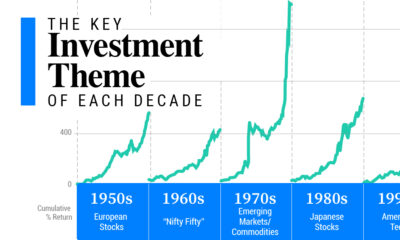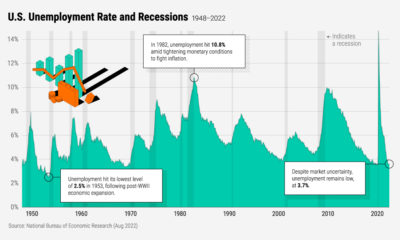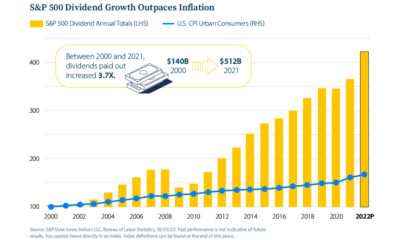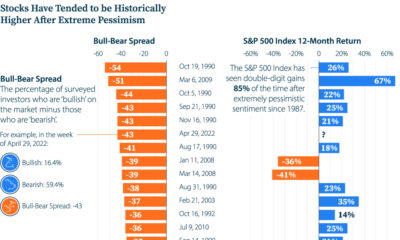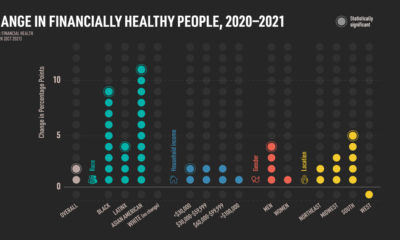This Markets in a Minute Chart is available as a poster.
Historical Stock Market Returns
After the fastest bear market drop in history, the S&P 500 rallied and now has a year-to-date total return of -4.7%. The year is not over, but in the context of history, is this in line with what’s considered a “normal” return, or is it more of an outlier?
In today’s Markets in a Minute chart from New York Life Investments, we show the distribution of U.S. equity returns over almost 200 years.
Total Returns By Year
The chart shows total annual returns, which assumes that dividends and other cash distributions are reinvested back into the index.
It’s also important to note that different indexes and data collection methods are used over the timeframe. From 1825-1925, numbers come from researchers at Yale University and Pennsylvania State University. They collected price and dividend data for almost all stocks listed on the New York Stock Exchange during its early history.
From 1926-1956, returns are from the S&P 90, the S&P 500’s predecessor. Finally, from 1957 to date, returns are based on the S&P 500.
Here are historical stock market returns by year:
| Year | Total Return |
| 1825 | -10.46% |
| 1826 | 0.81% |
| 1827 | -3.28% |
| 1828 | -15.13% |
| 1829 | 13.54% |
| 1830 | 30.14% |
| 1831 | -15.35% |
| 1832 | 11.62% |
| 1833 | -3.16% |
| 1834 | 11.75% |
| 1835 | -3.91% |
| 1836 | 5.92% |
| 1837 | -15.91% |
| 1838 | 18.47% |
| 1839 | -21.34% |
| 1840 | 6.54% |
| 1841 | -18.66% |
| 1842 | 8.11% |
| 1843 | 46.34% |
| 1844 | 9.66% |
| 1845 | -7.46% |
| 1846 | 26.57% |
| 1847 | 13.20% |
| 1848 | 10.45% |
| 1849 | 15.40% |
| 1850 | 14.21% |
| 1851 | -1.35% |
| 1852 | 22.59% |
| 1853 | -4.03% |
| 1854 | -18.35% |
| 1855 | 18.34% |
| 1856 | 5.49% |
| 1857 | -20.82% |
| 1858 | 13.22% |
| 1859 | 2.24% |
| 1860 | -1.53% |
| 1861 | -0.52% |
| 1862 | 52.75% |
| 1863 | 44.47% |
| 1864 | 14.71% |
| 1865 | 2.64% |
| 1866 | 4.85% |
| 1867 | 1.88% |
| 1868 | - |
| 1869 | 1.33% |
| 1870 | 2.77% |
| 1871 | 9.20% |
| 1872 | 6.83% |
| 1873 | -11.19% |
| 1874 | 1.70% |
| 1875 | 1.89% |
| 1876 | -6.45% |
| 1877 | 7.05% |
| 1878 | 16.04% |
| 1879 | 57.10% |
| 1880 | 25.12% |
| 1881 | 7.36% |
| 1882 | -4.22% |
| 1883 | -9.39% |
| 1884 | -18.47% |
| 1885 | 50.85% |
| 1886 | 16.69% |
| 1887 | -7.70% |
| 1888 | 6.45% |
| 1889 | 8.77% |
| 1890 | -6.59% |
| 1891 | 7.74% |
| 1892 | 14.79% |
| 1893 | -12.33% |
| 1894 | 1.94% |
| 1895 | 6.56% |
| 1896 | 4.86% |
| 1897 | 18.41% |
| 1898 | 16.38% |
| 1899 | 7.89% |
| 1900 | 22.97% |
| 1901 | 29.26% |
| 1902 | 9.44% |
| 1903 | -8.53% |
| 1904 | 19.66% |
| 1905 | 10.67% |
| 1906 | 3.10% |
| 1907 | -21.79% |
| 1908 | 34.56% |
| 1909 | 22.99% |
| 1910 | -10.94% |
| 1911 | 7.37% |
| 1912 | 5.30% |
| 1913 | -9.32% |
| 1914 | -3.25% |
| 1915 | 21.73% |
| 1916 | 7.19% |
| 1917 | -16.44% |
| 1918 | 11.27% |
| 1919 | 16.09% |
| 1920 | -15.02% |
| 1921 | 11.02% |
| 1922 | 26.72% |
| 1923 | 3.90% |
| 1924 | 25.77% |
| 1925 | 29.12% |
| 1926 | 11.62% |
| 1927 | 37.49% |
| 1928 | 43.61% |
| 1929 | -8.42% |
| 1930 | -24.90% |
| 1931 | -43.34% |
| 1932 | -8.19% |
| 1933 | 53.99% |
| 1934 | -1.44% |
| 1935 | 47.67% |
| 1936 | 33.92% |
| 1937 | -35.03% |
| 1938 | 31.12% |
| 1939 | -0.41% |
| 1940 | -9.78% |
| 1941 | -11.59% |
| 1942 | 20.34% |
| 1943 | 25.90% |
| 1944 | 19.75% |
| 1945 | 36.44% |
| 1946 | -8.07% |
| 1947 | 5.71% |
| 1948 | 5.50% |
| 1949 | 18.79% |
| 1950 | 31.71% |
| 1951 | 24.02% |
| 1952 | 18.37% |
| 1953 | -0.99% |
| 1954 | 52.62% |
| 1955 | 31.56% |
| 1956 | 6.56% |
| 1957 | -10.78% |
| 1958 | 43.36% |
| 1959 | 11.96% |
| 1960 | 0.47% |
| 1961 | 26.89% |
| 1962 | -8.73% |
| 1963 | 22.80% |
| 1964 | 16.48% |
| 1965 | 12.45% |
| 1966 | -10.06% |
| 1967 | 23.98% |
| 1968 | 11.06% |
| 1969 | -8.50% |
| 1970 | 4.01% |
| 1971 | 14.31% |
| 1972 | 18.98% |
| 1973 | -14.66% |
| 1974 | -26.47% |
| 1975 | 37.20% |
| 1976 | 23.84% |
| 1977 | -7.18% |
| 1978 | 6.56% |
| 1979 | 18.44% |
| 1980 | 32.42% |
| 1981 | -4.91% |
| 1982 | 21.55% |
| 1983 | 22.56% |
| 1984 | 6.27% |
| 1985 | 31.73% |
| 1986 | 18.67% |
| 1987 | 5.25% |
| 1988 | 16.61% |
| 1989 | 31.69% |
| 1990 | -3.10% |
| 1991 | 30.47% |
| 1992 | 7.62% |
| 1993 | 10.08% |
| 1994 | 1.32% |
| 1995 | 37.58% |
| 1996 | 22.96% |
| 1997 | 33.36% |
| 1998 | 28.58% |
| 1999 | 21.04% |
| 2000 | -9.10% |
| 2001 | -11.89% |
| 2002 | -22.10% |
| 2003 | 28.68% |
| 2004 | 10.88% |
| 2005 | 4.91% |
| 2006 | 15.79% |
| 2007 | 5.49% |
| 2008 | -37.00% |
| 2009 | 26.46% |
| 2010 | 15.06% |
| 2011 | 2.11% |
| 2012 | 16.00% |
| 2013 | 32.39% |
| 2014 | 13.69% |
| 2015 | 1.38% |
| 2016 | 11.96% |
| 2017 | 21.83% |
| 2018 | -4.38% |
| 2019 | 31.49% |
Source: Journal of Financial Markets, Slickcharts. The year 1868 has insufficient data to estimate a total annual return.
U.S. equity returns roughly follow a bell curve, meaning that values cluster near a central peak and values farther from the average are less common. Historically, they have been skewed towards positive performance.
Here is how the distribution of returns stack up:
| Total Annual Return (%) | -50 to -30 | -30 to -10 | -10 to 10 | 10 to 30 | 30 to 50 | 50+ |
| Number of Years Within Range | 3 | 23 | 76 | 65 | 22 | 5 |
| Percent of Years Within Range | 1.5% | 11.9% | 39.2% | 33.5% | 11.3% | 2.6% |
While extreme returns can happen, almost 40% of annual returns have fallen within the -10% to 10% range.
Recessions and Recoveries
What does it look like when more abnormal returns occur? Due to the cyclical nature of the economy, recessions tend to be followed by strong recoveries.
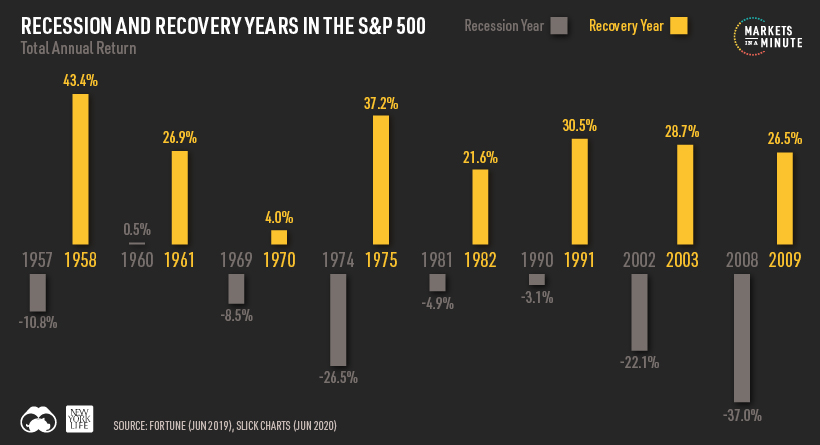
In 1957, the year the S&P 500 was created, the stock market saw a loss of almost 11%. Stock prices shot up by over 43% the following year, bolstered by rising credit volumes and business profits.
Most recently, the 2008 global financial crisis led to one of the largest equity losses to date. In 2009, stocks climbed by almost 27%, boosted by expectations of higher capital spending and demand as the economy recovered.
What History Tells Us
While equities can have high volatility, returns have historically followed a positively-skewed bell curve distribution. From 1825-2019, the average total annual return was 9.56%. In fact, over 70% of total annual returns have been positive over the same timeframe.
Owning stocks long-term may help investors not only beat inflation, but also build a nest egg that may sustain them throughout their retirement years.

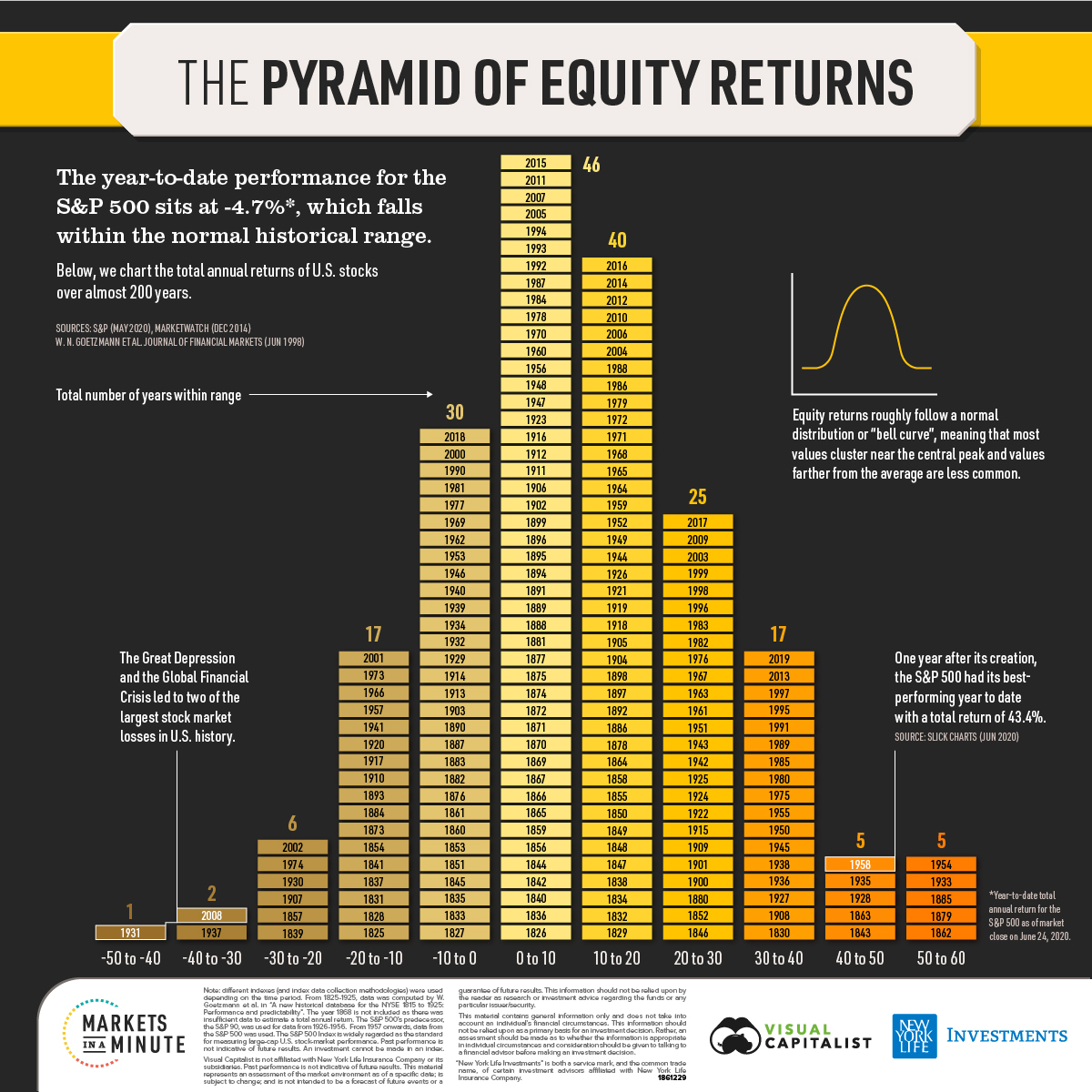
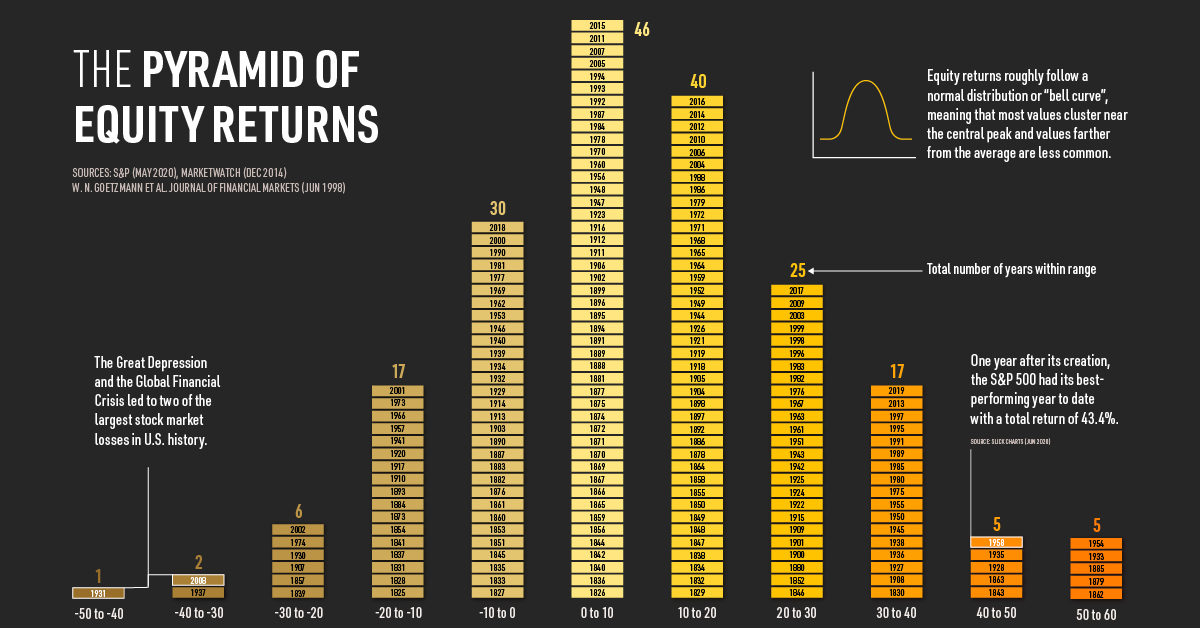

 Infographics2 years ago
Infographics2 years ago
 Markets in a Minute2 years ago
Markets in a Minute2 years ago
 Markets in a Minute2 years ago
Markets in a Minute2 years ago
 Infographics2 years ago
Infographics2 years ago
 Markets in a Minute1 year ago
Markets in a Minute1 year ago
 Infographics3 years ago
Infographics3 years ago
 Markets in a Minute2 years ago
Markets in a Minute2 years ago
 Infographics1 year ago
Infographics1 year ago


